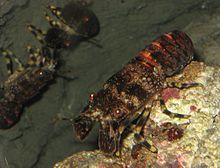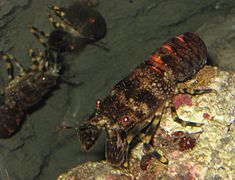슬리퍼 랍스터
Slipper lobster| 슬리퍼 랍스터 시간 범위 : ~ Ma Pre O T K N | |
|---|---|
 | |
| 스켈라리데스라투스 | |
| 과학적 분류 | |
| 왕국: | 애니멀리아 |
| 문: | 절지동물 |
| 하위문: | 갑각류 |
| 클래스: | 말라코스트라카 |
| 주문: | 데카포다 |
| 인프라스트럭처: | 아켈라타 |
| 패밀리: | 스켈라루스과 라트레이유, 1825년 |
| 아과 | |
| |
슬리퍼 랍스터는 모든 따뜻한 바다와 바다에서 발견되는 데카포다 분지(Decapoda clade)의 약 90종의 아켈레이트 갑각류 동물 과입니다.그들은 진짜 랍스터는 아니지만 가시가 많은 랍스터와 털북숭이 랍스터에 더 가깝다.슬리퍼 랍스터는 머리에서 앞쪽으로 넓은 판처럼 튀어나온 커다란 더듬이에 의해 즉시 알아볼 수 있습니다.슬리퍼 랍스터의 모든 종은 먹을 수 있고, 모레톤 베이 벌레와 발메인 벌레와 같은 몇몇 종은 상업적으로 중요하다.
묘사
슬리퍼 랍스터는 머리에는 6개의 조각이 있고 가슴에는 8개의 조각이 있는데, 이들은 두꺼운 갑옷으로 총체적으로 덮여 있다.복부의 여섯 부분은 각각 한 쌍의 흉부를 가지고 있는 반면, 흉부 부속지는 걷는 다리 또는 상악골이다.머리 부분에는 다양한 입 부분과 두 쌍의 더듬이가 있습니다.첫 번째 더듬이 또는 더듬이는 길고 유연한 줄기에 고정되어 있으며 환경을 감지하는 데 사용됩니다.두 번째 더듬이는 슬리퍼 랍스터의 가장 두드러진 특징인데,[3] 그것은 슬리퍼 랍스터의 머리로부터 수평으로 앞으로 뻗어나가는 큰 판으로 확장되고 평평해지기 때문이다.
슬리퍼 바닷가재는 종류에 따라 크기가 상당히 다르다.지중해산 Scylarus pygmaeus는 가장 작은 종으로, 최대 총 길이가 55밀리미터(2.2인치)[4]로 자라며, 드물게 40밀리미터를 넘습니다.가장 큰 종인 Scylarides haanii는 길이가 [5]50cm에 이를 수 있다.
생태학
슬리퍼 랍스터는 일반적으로 대륙붕의 바닥에서 살고 있으며, 최대 수심 500미터(1,600피트)[6]에서 발견됩니다.슬리퍼 랍스터는 갑각류, 다년생, [8]극피동물뿐만 아니라 림프, 홍합, [7]굴을 포함한 다양한 연체동물을 먹습니다.그들은 천천히 자라고 상당한 나이까지 삽니다.그들은 다른 갑각류 갑각류들이 꼬리 뒤집기를 할 수 있게 해주는 거대한 뉴런이 부족하고, 기질에 묻히고 중무장한 [9]외골격에 의존하는 것과 같은 포식자의 공격을 피하기 위해 다른 수단에 의존해야 한다.
슬리퍼 랍스터의 가장 중요한 포식자는 뼈 있는 물고기이며, 회색 [7]방아쇠고기는 지중해에서 Scylarides latus의 가장 중요한 포식자입니다.
라이프 사이클
어린 슬리퍼 랍스터는 알에서 부화한 후 잎과 같은 플랑크톤 [10]모양의 엽종 유충으로 약 10개의 발등을 통과합니다.이 10여 개의 단계는 1년의 대부분 동안 지속되며, 그 후 유충은 몇 주 동안 지속되는 "nisto" 단계로 탈피합니다.이 단계에서 성인으로의 이행에 대해서는 거의 알려진 것이 없으며, 이 이행은 일련의 [3]털갈이를 통해 계속 성장한다.
상업적 중요성
비록 그들이 어디서 발견되든 낚시를 하지만, 슬리퍼 랍스터는 가시가 많은 랍스터나 진짜 [11]랍스터와 같은 격렬한 어업의 대상이 되지 않았다.슬리퍼 랍스터를 잡는 방법은 그 종의 생태에 따라 다르다.테누스나 이바쿠스처럼 부드러운 기판을 선호하는 사람들은 트롤 어선에 자주 잡히고, 틈새, 동굴, 암초(스켈라리드, 아크티데스, 파리바쿠스 종 포함)를 선호하는 사람들은 스쿠버 [6]다이버들에 의해 주로 잡힌다.
1991년 전 세계 슬리퍼 바닷가재의 어획량은 2100톤(길이 2100톤, 쇼트톤 2300톤)[12]으로 보고됐다.최근 연간 생산량은 약 5000t(4900longt, shorttt)으로,[13] 이 중 대부분이 아시아에서 생산되고 있다.
통용명
Scylaridae과에는 많은 통칭이 사용되고 있다.이들 중 가장 흔한 것은 "슬리퍼 [2][6]랍스터"이고, "쇼핑코 [14]랍스터"와 "로커스트 랍스터"가 그 뒤를 잇는다."스페인 바닷가재"[15]는 Arctides, "mitten 랍스터"는 Parribacus,[16] "fan 랍스터"는 Evibacus와[17] Ibacus에 [18]사용됩니다.호주에서는 특히 [19]이바쿠스속에 속하는 많은 종들을 "벌레"라고 부릅니다.호주에서 사용되는 다른 이름으로는 "베이 랍스터", "블라인드 랍스터", "플랩잭", "플랫 랍스터", "날아다니는 랍스터", "걸프 랍스터", "머드버그", "샌드버그", "쇼벨노즈 랍스터", "크레이피쉬", "슬리퍼" 및 스쿼그 [20]등이 있습니다.더 희귀한 용어로는 "평두 바닷가재"[21]와 "불도저 바닷가재"[22]가 있습니다.그리스에서 그들은 대략 '범 타자'로 번역되는 코로크 타입으로 알려져 있다.22개 속은 [23]2002년 Lipke Holthuis에 의해 이전에 Scylarus로 [24]분류된 종으로 명명되었다.
속
슬리퍼 랍스터는 다음 속에 속합니다.
| Scylarinae Latreille, 1825
| 홀투이스과(Actidinae Holthuis 이바시내 홀투이스, 1985 Theninae Holthuis, 1985
|
갤러리
다양한 종류의 슬리퍼 랍스터 갤러리:
Thernus Orientalis (조리)
화석 기록
슬리퍼 랍스터의 화석 기록은 1억-1억2천만 년 전으로 거슬러 올라가는데, 이는 슬리퍼 랍스터의 가장 가까운 친척인 가시 랍스터보다 훨씬 적은 것이다.한 가지 중요한 초기 화석은 적어도 1억 4천 2백만 년 전 쥐라기 후기 퇴적물에서 묘사된 칸크리노스 클라비거로,[22] 현생 슬리퍼 [25]랍스터의 조상 또는 스켈라과 센수 스트ricto과의 자매 집단을 나타낼 수 있다.
레퍼런스
- ^ "Scyllaridae Latreille, 1825". Integrated Taxonomic Information System. Retrieved October 21, 2011.
- ^ a b Gary Poore & Michael Türkay (February 24, 2009). "Scyllaridae". World Register of Marine Species. Retrieved January 21, 2010.
- ^ a b Kari L. Lavalli & Ehud Spanier (2007). "Introduction to the biology and fisheries of slipper lobsters". In Kari L. Lavalli & Ehud Spanier (eds.). The Biology and Fisheries of the Slipper Lobster. Crustacean Issues. Vol. 17. CRC Press. pp. 3–24. ISBN 978-0-8493-3398-9.
- ^ Lipke B. Holthuis (1991). "Scyllarus pygmaeus". Marine Lobsters of the World. FAO Fisheries Synopsis No. 125. Food and Agriculture Organization. pp. 224–225. ISBN 92-5-103027-8.
- ^ Lipke B. Holthuis (1991). "Scyllarides haanii". Marine Lobsters of the World. FAO Fisheries Synopsis No. 125. Food and Agriculture Organization. p. 189. ISBN 92-5-103027-8.
- ^ a b c "Family SCYLLARIDAE Latreille, 1825". Australian Faunal Directory. Department of the Environment, Water, Heritage and the Arts. January 8, 2010.
- ^ a b E. Spanier & K. L. Lavalli (1998). "Natural history of Scyllarides latus (Crustacea: Decapoda): a review of the contemporary biological knowledge of the Mediterranean slipper lobster". Journal of Natural History. 32 (10 & 11): 1769–1786. doi:10.1080/00222939800771281.
- ^ D. Miner; G. Allinson; S. Salzman; M. Nishikawa & N. Turoczy (2006). "Trace metal concentrations in the Balmain bug (Ibacus peronii Leach, 1815) from southwest Victoria, Australia". Bulletin of Environmental Contamination and Toxicology. 76 (6): 1007–1013. doi:10.1007/s00128-006-1018-7. PMID 16855908. S2CID 12826038.
- ^ Sandra Y. Espinoza; Lana Breen; Nisha Varghese & Zen Faulkes (2006). "Loss of escape-related giant neurons in a spiny lobster, Panulirus argus". Biological Bulletin. 211 (3): 223–231. doi:10.2307/4134545. JSTOR 4134545. PMID 17179382.
- ^ Nariaki Inoue & Hideo Sekiguchi (2005). "Distribution of scyllarid phyllosoma larvae (Crustacea: Decapoda: Scyllaridae) in the Kuroshio Subgyre". Journal of Oceanography. 61 (3): 389–398. doi:10.1007/s10872-005-0049-8. S2CID 55564480.
- ^ Ehud Spanier & Kari L. Lavalli (2007). "Directions for future research in slipper lobster biology". In Kari L. Lavalli & Ehud Spanier (eds.). The Biology and Fisheries of the Slipper Lobster. Crustacean Issues. Vol. 17. CRC Press. pp. 221–228. ISBN 978-0-8493-3398-9.
- ^ Lipke B. Holthuis (1991). Marine Lobsters of the World. FAO Fisheries Synopsis No. 125. Food and Agriculture Organization. ISBN 92-5-103027-8.
- ^ "Global Production". Fishery Statistics programme. Food and Agriculture Organization. Retrieved January 21, 2010.
- ^ Karen Gowlett-Holmes. "Taxon Report: Scyllaridae". Commonwealth Scientific and Industrial Research Organisation. Retrieved January 21, 2010.
- ^ "Arctides Holthuis, 1960". Integrated Taxonomic Information System. Retrieved October 21, 2011.
- ^ "Parribacus Dana, 1852". Integrated Taxonomic Information System. Retrieved October 21, 2011.
- ^ "Evibacus Smith, 1869". Integrated Taxonomic Information System. Retrieved October 21, 2011.
- ^ "Ibacus Leach, 1815". Integrated Taxonomic Information System. Retrieved October 21, 2011.
- ^ "Bugs (Ibacus spp.)" (PDF). New South Wales Department of Primary Industries. Retrieved January 21, 2010.
- ^ "Fish names: Balmain bug". Seafood Services Australia. Retrieved January 21, 2010.
- ^ "Thenus orientalis (Lund, 1793)". Integrated Taxonomic Information System. Retrieved October 21, 2011.
- ^ a b Joachim T. Haug; Carolin Haug; Dieter Waloszek; Andreas Maas; Matthias Wulf & Günter Schweigert (2009). "Development in Mesozoic scyllarids and implications for the evolution of Achelata (Reptantia, Decapoda, Crustacea)" (PDF). Palaeodiversity. 2: 97–110.
- ^ Sammy De Grave; N. Dean Pentcheff; Shane T. Ahyong; et al. (2009). "A classification of living and fossil genera of decapod crustaceans" (PDF). Raffles Bulletin of Zoology. Suppl. 21: 1–109.
- ^ Lipke Holthuis (2002). "The Indo-Pacific scyllarine lobsters (Crustacea, Decapoda, Scyllaridae)" (PDF). Zoosystema. 24 (3): 499–683.
- ^ W. Richard Webber & John D. Booth (2007). "Taxonomy and evolution". In Kari L. Lavalli & Ehud Spanier (eds.). The Biology and Fisheries of the Slipper Lobster. Crustacean Issues. Vol. 17. CRC Press. pp. 25–52. ISBN 978-0-8493-3398-9.
추가 정보
- Kari L. Lavalli; et al., eds. (2007). The biology and fisheries of the slipper lobster. Boca Raton (Fla.): CRC/Taylor & Francis. doi:10.1201/9781420005165. ISBN 9780849333989.
외부 링크
 위키종 Scylaridae 관련 자료
위키종 Scylaridae 관련 자료 Wikimedia Commons의 Scylaridae 관련 미디어
Wikimedia Commons의 Scylaridae 관련 미디어








